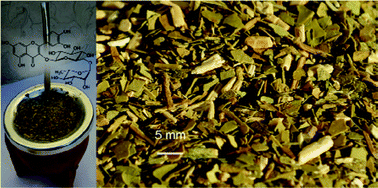Biospectroscopy, biospectrometry and imaging of Ilex paraguariensis. Basis for non-destructive quality evaluation using artificial vision†
Abstract
Yerba mate (YM) is massively produced and consumed as an infusion in South America and is gaining popularity all over the world. This product is obtained from the dried leaves of Ilex paraguariensis Saint Hilaire, mixed with fragments of its dried branches. For its commercialization YM must have a minimum percentage of leaves according to a standard classification. Until now, composition quantification has been mechanically performed, thus development of new methods is still pending. In this work a quantification method using solid-phase molecular fluorescence, alternately diffuse reflectance spectroscopy and an imaging technique using a scanner have been proposed. Strong differences between the spectroscopic properties of leaves and sticks were observed and in all the cases linear correlations between the processed signals and composition were observed. Interesting differences in chemical composition of YM leaves and sticks were additionally obtained in this work by means of total phenol content quantification, ultraviolet matrix assisted laser-desorption ionization mass spectrometry and ultraviolet laser-desorption ionization mass spectrometry.


 Please wait while we load your content...
Please wait while we load your content...